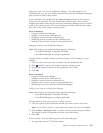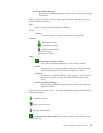
An example
You install SystemA in a lab with a ServeRAID Manager subsystem. You run the
ServeRAID Manager on SystemA to monitor for events and problems, but you
want to monitor from your workstation and not from SystemA. You open the
SystemA Notification Manager from the ServeRAID Manager and define your
workstation in the notification list. When running the ServeRAID Manager from
your workstation, you are notified of all problems and events that occur on
SystemA.
Note: You can use the Email Notification Manager to notify users of events by
email. This allows you to notify users who have not installed or are not
currently running ServeRAID Manager.
The Notification Manager and its events
Events generated by the Notification Manager include the following:
v Progress information, such as rebuilds, synchronizations, and migrations.
v Problems, such as defunct physical drives and PFA errors.
v Changes to the local configuration, such as creating a hot-spare drive or defining
a logical drive.
When
an event is generated on a system, the Notification Manager connects with
each system in the notification list and relays the event to these systems’
ServeRAID Manager. If the Notification Manager successfully connects and sends
the event, the notification list updates its ″ Last event sent″ column. If the
Notification Manager does not successfully connect or send the event, the
Notification Manager:
v Updates the ″Last event sent″ column with a
notifying you of a problem.
v Logs an event in the Notification Manager event viewer detailing why the event
could not be sent.
The
Notification Manager interface
The Notification Manager consists of the following:
Toolbar
Provides quick-path icons for common tasks.
Notification list
Displays the remote systems configured to receive event notification.
Notification event viewer
Displays status information for the Notification Manager.
In addition to displaying the events in the event viewer, the Notification
Manager appends each event to a logging file, RAIDNOT.LOG. If this file
exceeds 200 KB, the ServeRAID Manager copies the file to RAIDNOT.OLD
and creates a new RAIDNOT.LOG. If there is a RAIDNOT.OLD already,
the ServeRAID Manager overwrites it.
More
information
v Adding a system to the notification list
v Deleting a system from the notification list
v Modifying system properties in the notification list
v Sending a test event to a system in the notification list
152 ServeRAID Manager Installation and User's Guide





















